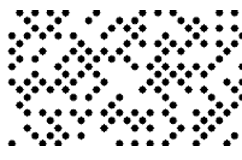In an age of RFID and Internet of Things (IoT) technologies – though both to be sure are still in their early stages – it's good to know there is still some development going on in good old fashion bar codes.
And so it is with a bar code symbology you likely have never heard of, something called DotCode. It was invented more than 10 years ago by Andrew Longacre, now retired after a long career Welch Allyn and then Honeywell after it acquired Welch Allyn.
Supply Chain Digest Says... |
 |
| As of mid-2017, one of the largest bar code scanning companies, Honeywell, said it had no scanners or printers that supported DotCode. Cognex does. |
 |
What do you say? |
| Click here to send us your comments |
 |
| Click here to see reader feedback |
|
|
It is a two-dimensional bar code that enables variable data such as lot, serial number, and expiration date to be encoded on small packages traveling down a high-speed production line.
The symbology received its first technical specification from the AIMGlobal (automatic identification manufacturers association) in 2009, but that standard is currently under minor revision and to date the DotCode has received relatively little adoption in industry.
But that could change. Traditional inkjet printers used to print bar codes on box labels or the corrugate itself struggle to produce quality bar codes on boxes moving rapidly on conveyor systems coming out of production areas – and those speeds continue to increase.
The game was changed in 2016, however, when Walmart informed its suppliers that soon it would not accept inkjet printing on cases for the 14-digit Global Trade Item Number (GTIN) and the bar code symbol representing that number by suppliers.
That, Walmart said, was due to scanning issues with poor quality inkjet bar codes, which it said sometimes could not be read with handheld scanners in its stores.
Instead, the mandate said those bar code must be printed by flexographic techniques – which would printing the codes not at the point of production but when the carton is initially created by the box supplier. (See Walmart Roiling Its Vendor World with New Carton Marking Requirements in Apparent Attempt to Reduce Out-of-Stocks.)
That in turn would mean that a Walmart vendor would have to maintain a separate inventory of empty cartons for each and every SKU.
That is very different than the practice used by most companies today, which print the case code using an "on-demand" approach, typically an inkjet printer, but also sometimes by applying a printed label typically produce by what is called a thermal transfer printer. This enables these companies to maintain a reduced set of carton inventories that are then customized for each SKU as they are coming off the production or packing line.
It is not clear how strictly if at all Walmart has enforced this mandate, but it certainly got suppliers stirred up.
So along comes DotCode, which could enable the GTIN number (and other data) to be printed with an inkjet printer with fewer read-rate issues – if Walmart and potentially other retailers would accept and be able to read the new code
(See More Below)
|
CATEGORY SPONSOR: SOFTEON |
|
|
| |
|
|
Previous efforts to improve the bar code quality without seriously slowing down conveyor speeds have been largely unsuccessful, providing an opportunity for an altogether different approach: a new type of barcode that is more tolerance to high conveyor speeds and the vagaries of ink jet technology, which the problem Longacre hoped to solve with DotCode.
DotCode's flexibility and high error correction capabilities makes it appealing to industries that require security and durability from the bar codes they use.
DotCode is printed as an array that is rectangular or square in shape, of height H (rows) and width W (columns), though practically the maximum is considered to be 124 x 124, with just half of the possible dot locations made available for printing, like the dark squares on a checker-board. A three-dot-wide "quiet zone" is required on all sides.
The code can take on various shapes and sizes depending on the placement needs within a given product context. In theory, the size can be virtually unlimited and take on rectangular or square shapes depending on the manufacturers design specifications.
Example DotCode 2D Bar Code Symbol

According to bar code imager company Cognex, DotCode has high-quality error correction capabilities. It is meant to remain readable even if the bar code is damaged during the manufacturing or shipping process. It can withstand poor printing and missing or additional dots, so if the code is damaged or has many printing errors, it should still scan.
It is also an open domain symbology, meaning it is freely available for any entity that wishes to use it and integrate it into their tracking and anti-counterfeiting needs. Some bar code scanning companies are starting to provide support for DotCode reads. However, as of mid-2017, one of the largest bar code scanning companies, Honrywell, said it had no scanners or printers that supported DotCode. It appears the Cognex has bar code imagers that can handle the symbology, however.
So we are early in the game, and information is not abundant, but if you are looking for improved read rates from laser or inkjet printers running on high speed manufacturing lines, DotCode may – someday – be a solution.
Do you have any insight on the DotCode? Anyone using it yet? Let us know your thoughts at the Feedback section below.
Your Comments/Feedback
|